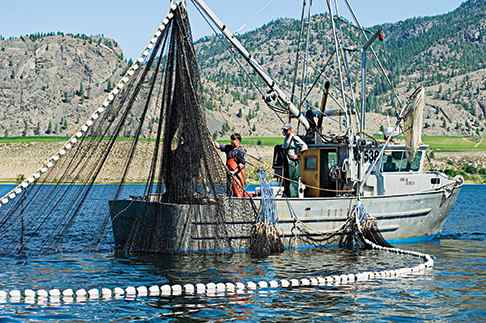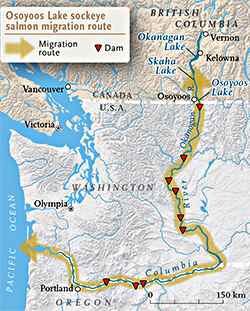forum
library
tutorial
contact

The Return of (Canadian) Sockeye Salmon
by Jennifer Cockrall-KingCanadian Geographic, July / August 2015
|
the film forum library tutorial contact |

|
The Return of (Canadian) Sockeye Salmonby Jennifer Cockrall-KingCanadian Geographic, July / August 2015 |
 Casmir Tonasket, a fisheries technician with the Okanagan Nation Alliance, advises that we sit as he opens the throttle of his research boat. He has spotted action on the Marion Michelle, a 12-metre purse seiner -- definitely an eye-catching sight on Osoyoos Lake, the southernmost lake in British Columbia's Okanagan Valley. He grins as we approach the ship. Four burly men are hauling up a net hand-over-hand. Two more assist from a low-sided packing boat. The water boils with fish and cheers erupt from both boats. Thirty-some sockeye salmon go from the net into plastic tubs on the packing boat.
Casmir Tonasket, a fisheries technician with the Okanagan Nation Alliance, advises that we sit as he opens the throttle of his research boat. He has spotted action on the Marion Michelle, a 12-metre purse seiner -- definitely an eye-catching sight on Osoyoos Lake, the southernmost lake in British Columbia's Okanagan Valley. He grins as we approach the ship. Four burly men are hauling up a net hand-over-hand. Two more assist from a low-sided packing boat. The water boils with fish and cheers erupt from both boats. Thirty-some sockeye salmon go from the net into plastic tubs on the packing boat.
A catch of 30 salmon might not seem noteworthy; some hauls can be in the hundreds. But for the Okanagan Nation Alliance -- the seven Syilx-speaking tribes of British Columbia's Interior and the Colville Federated Tribes in the United States -- the return of the sockeye to Osoyoos Lake has been more than 10 years in the making. Each haul -- each fish, in fact -- is a triumph.
Unlike the smaller kokanee salmon, which stay in lakes, ocean-going sockeye from Osoyoos Lake face a 1,000-kilometre migration across the United States border and through the Okanagan-Columbia river system to the Pacific Ocean. For two to three years, these adolescent salmon feed hundreds of kilometres out in the open ocean, at the risk of natural predation and open-ocean fishing operations. Those that survive at sea face an even more perilous return trip to Osoyoos Lake to spawn, then die.
It's not merely a question of a marathon swim upstream. Since the 1940s, nine hydroelectric dams have been built along their route. The rivers and channels of this watershed have also been altered and straightened for transportation and industry, leaving fish few places to rest along the way. In 1995, only about 5,000 sockeye returned to Osoyoos Lake, and the once great run looked like it would collapse completely.
 Fortunately, the Okanagan Nation Alliance was not about to let such an important traditional food vanish without a fight. Striking a partnership with the Department of Fisheries and Oceans in Canada and the U.S. Army Corps of Engineers for the American portion of the waterway, a hatchery project was launched in 2003. Since then, slow, steady progress -- combining hatchery and migratory fishpassage science with habitat restoration and transborder stewardship -- has begun to yield encouraging results.
Fortunately, the Okanagan Nation Alliance was not about to let such an important traditional food vanish without a fight. Striking a partnership with the Department of Fisheries and Oceans in Canada and the U.S. Army Corps of Engineers for the American portion of the waterway, a hatchery project was launched in 2003. Since then, slow, steady progress -- combining hatchery and migratory fishpassage science with habitat restoration and transborder stewardship -- has begun to yield encouraging results.
For the past few years, hundreds of thousands of sockeye have been making it back across the border into Osoyoos Lake. The fish were plentiful enough that in 2010 the Department of Fisheries and Oceans licensed the Okanagan Nation Alliance for a pilot fishing enterprise. That year, 778 sockeye were caught in Osoyoos Lake and sold into the wider community. In 2011, about 6,000 fish were taken from the lake. In 2012, about 63,000 were caught. Each year, fisheries managers have ensured that enough fish are left in the lake to maintain a healthy spawning population; last year, for instance, more than 100,000 were left to keep rebuilding stocks.
Despite those numbers, the sustainability of the run is still far from certain, so it's imperative to continue building capacity and repairing habitat loss. The Okanagan Nation Alliance also plans to expand the salmon run farther north, into the larger, colder Skaha and Okanagan lakes (in May, sockeye fry were released for the first time in the Penticton channel that runs between the two lakes). But for now, there's reason enough to celebrate. Numbers permitting, Tonasket and the fishermen of the Marion Michelle will be out on Osoyoos Lake again this July and August. A cornerstone of Okanagan food and culture is being recovered. And in a rare goodnews story about fish stocks, it looks like the Okanagan sockeye could be making many happy returns.
Related Pages:
Okanagan Sockeye Restoration Successful with Decade-long Effort by Mark Hume,The Globe and Mail, 9/21/14
More Rearing Habitat for Upper Columbia Sockeye: Cheap Fix Brings 'Incredible Biological Benefit' by Staff, Columbia Basin Bulletin, 7/25/14
Return of the Okanagan Sockeye by Jennifer Cockrall-King, Okanagan Life Magazine, 10/15/11
learn more on topics covered in the film
see the video
read the script
learn the songs
discussion forum
